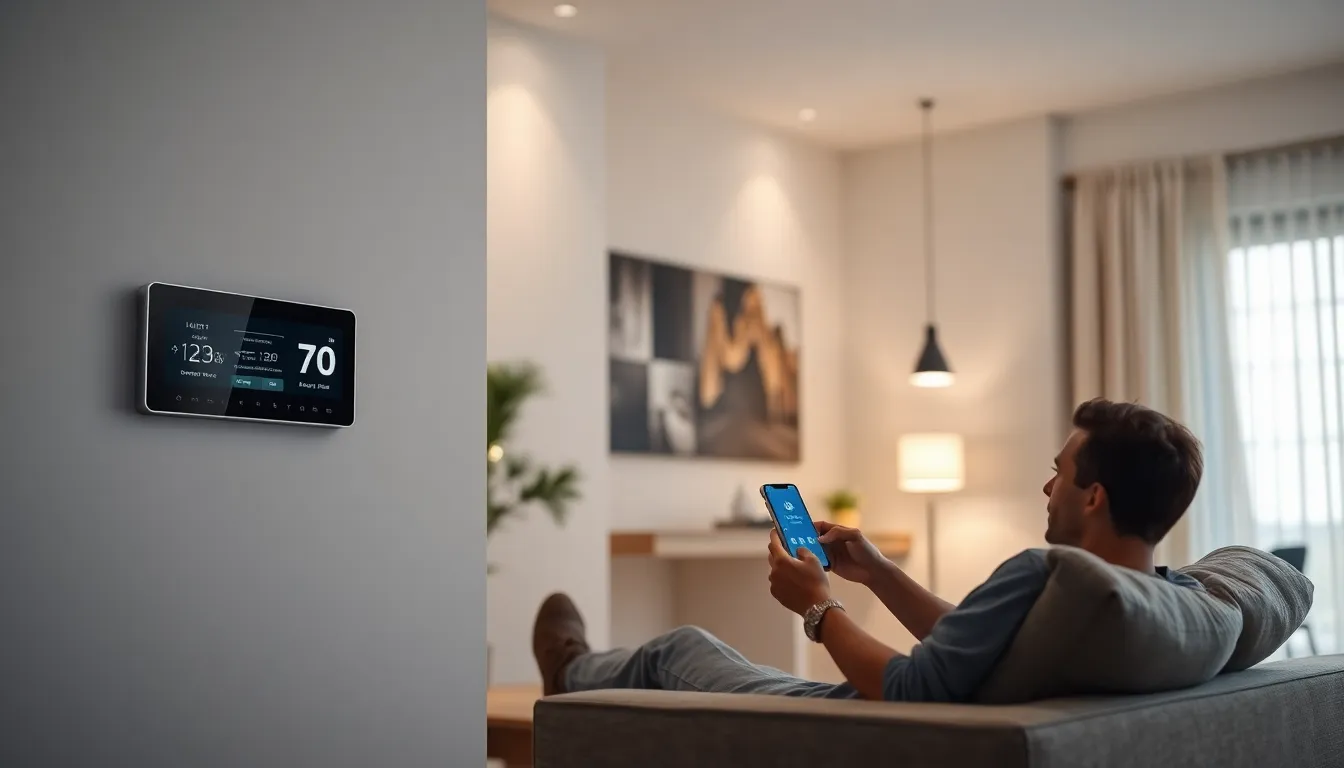Table of Contents
ToggleImagine waking up to the gentle hum of your coffee maker, the blinds rising to let in the morning sun, and your favorite playlist serenading you as you start your day. Welcome to the world of smart home automation, where convenience meets a sprinkle of magic. It’s not just about gadgets; it’s about transforming your living space into a personal assistant that knows your needs better than your best friend.
With smart home technology, everyday tasks become a breeze. Forget fumbling for light switches or battling with the thermostat. Instead, you’ll have a home that responds to your voice, your schedule, and even your mood. Whether it’s dimming the lights for movie night or locking the doors when you forget, smart home automation is like having a butler—without the bow tie and awkward small talk. Dive into this exciting realm and discover how to make your home smarter, one gadget at a time.
Overview of Smart Home Automation
Smart home automation transforms traditional living into a connected experience. Devices such as smart thermostats, lights, and security systems work together to create a cohesive environment. Many homeowners benefit from the convenience of controlling these devices remotely through smartphones or voice commands.
Energy efficiency ranks high among the advantages of smart automation. For instance, smart thermostats can adjust heating and cooling based on user habits. This capability results in reduced energy bills and a smaller carbon footprint.
Integration forms the backbone of smart home systems. These systems often utilize hubs, which act as central points for communication between devices. Popular protocols include Wi-Fi, Zigbee, and Z-Wave, allowing various brands to collaborate seamlessly.
User experience remains a critical element. Personalization options enable customization based on individual preferences and routines. Homeowners can schedule lights to dim at specific times or set the temperature to rise before returning home.
Security enhancement also plays a significant role in smart automation. With smart cameras and doorbell systems, users can monitor their property in real-time. Notifications alert homeowners to movements, ensuring peace of mind while away.
Accessibility features empower diverse users. Voice-activated assistants and app interfaces facilitate control for individuals with mobility challenges. Smart home technology fosters inclusivity by allowing everyone to engage with their living spaces.
Cost considerations often arise when exploring smart home automation. Initial investments in devices and installation should align with long-term savings. Many consumers find that the enhanced quality of life justifies these expenditures, making homes smarter and more efficient.
Benefits of Smart Home Automation

Smart home automation significantly enhances daily living, providing various advantages such as convenience, comfort, and energy savings.
Convenience and Comfort
Automation simplifies everyday tasks. Users can easily control lighting, temperature, and security systems with voice commands or mobile apps. Smart technology fosters an environment that responds to individual routines. For instance, lights adjust automatically based on occupancy, ensuring rooms remain well-lit or dimmed as needed. Furthermore, personalized schedules for heating and cooling enhance comfort levels throughout the day. As a result, users enjoy a seamless living experience tailored to their preferences, reducing effort while maximizing relaxation.
Energy Efficiency
Smart home automation drives energy efficiency. Automated systems like smart thermostats optimize heating and cooling based on specific usage patterns. Data shows that these devices can reduce energy consumption by around 20% annually. Smart lights, which turn off when no one is present, likewise contribute to lower utility bills. Furthermore, programmable plugs help manage energy use by scheduling devices to operate only during off-peak times. Overall, these advancements lead to significant savings over time while promoting a more sustainable living environment.
Key Components of Smart Home Systems
Smart home systems consist of various interconnected components that enhance functionality and user experience. Each component plays a unique role in creating an automated living environment.
Smart Devices
Smart devices serve as the backbone of home automation. These gadgets include smart lights, thermostats, security cameras, and door locks. Smart lights allow users to control brightness and color through mobile apps or voice commands. Smart thermostats adapt heating and cooling settings based on user behavior and preferences. Security cameras provide real-time video feeds and motion alerts, ensuring safety. Door locks enable remote locking and unlocking, enhancing convenience. User-friendly interfaces make controlling these devices intuitive. The integration of multiple smart devices leads to streamlined control and increased efficiency.
Central Hubs and Controllers
Central hubs act as communication centers for smart home devices. They connect gadgets using protocols such as Wi-Fi, Zigbee, and Z-Wave. Hubs enable seamless interaction among devices, allowing users to manage them from a single platform. Controllers often include smartphones, tablets, or dedicated remotes that empower users to execute complex commands easily. Smart home app interfaces provide intuitive navigation and automation options, enhancing the overall user experience. With reliable central hubs, users can enjoy a synchronized smart home system that operates cohesively, simplifying daily routines and boosting comfort.
Popular Smart Home Automation Technologies
Smart home automation relies on various technologies to enhance user experience. Key innovations include voice assistants and IoT integration, enabling seamless control of devices.
Voice Assistants
Voice assistants like Amazon Alexa and Google Assistant serve as central command centers for smart homes. These platforms accept voice commands, allowing users to control lights, thermostats, and more effortlessly. Integration matters; voice assistants connect with a range of smart devices, ensuring a streamlined experience. Users enjoy hands-free operation, leading to increased convenience during daily activities. Personalization is achievable too; voice assistants learn preferences over time, refining responses to specific requests. Security also benefits, as users can monitor their home systems vocally, enhancing peace of mind.
IoT Integration
IoT integration is essential for smart home automation, enabling devices to communicate and operate in harmony. Many smart devices utilize IoT protocols to form a unified network. This connectivity allows homeowners to monitor and control devices remotely, increasing convenience and energy efficiency. Real-time data sharing supports intelligent decision-making; for example, smart thermostats adjust heating based on data received from other sensors. User experience improves significantly with IoT, as automation simplifies routine tasks. Enhanced interoperability champions flexibility, allowing homeowners to customize their smart environments easily.
Challenges and Considerations
Smart home automation presents several challenges that homeowners should consider before fully integrating such systems. Evaluating these issues ensures a smoother experience and maximizes the benefits of a connected living environment.
Security Concerns
Security remains a top concern in smart home automation. Hackers often target vulnerable devices and networks, leading to unauthorized access. Users must regularly update firmware and implement strong passwords to protect their systems. Investing in devices with robust encryption and security features provides additional peace of mind. Utilizing two-factor authentication enhances security further, safeguarding personal information against potential breaches. Regular monitoring of connected devices can help detect anomalies early, bolstering overall home security.
Compatibility Issues
Compatibility between devices poses another challenge for homeowners. Not all smart devices integrate seamlessly, which can create frustration during setup and operation. Different manufacturers may use various protocols, affecting the functionality of interconnected systems. Researching compatibility before purchasing helps prevent integration issues down the line. Choosing devices that support universal communication standards, like Wi-Fi or Zigbee, streamlines connectivity. Using a versatile smart hub facilitates the better management of devices, ensuring a cohesive smart home experience.
Smart home automation is revolutionizing the way people interact with their living spaces. By integrating various devices into a cohesive system homeowners can enjoy unparalleled convenience and efficiency. The ability to personalize settings based on individual preferences not only enhances comfort but also promotes energy savings.
As technology continues to advance the possibilities for smart homes will only expand. Embracing this innovation allows for a more connected lifestyle where daily tasks become effortless. With careful consideration of security and compatibility challenges homeowners can confidently invest in smart technology that transforms their living environments.
Ultimately smart home automation represents a significant step towards a more efficient and enjoyable way of living.


